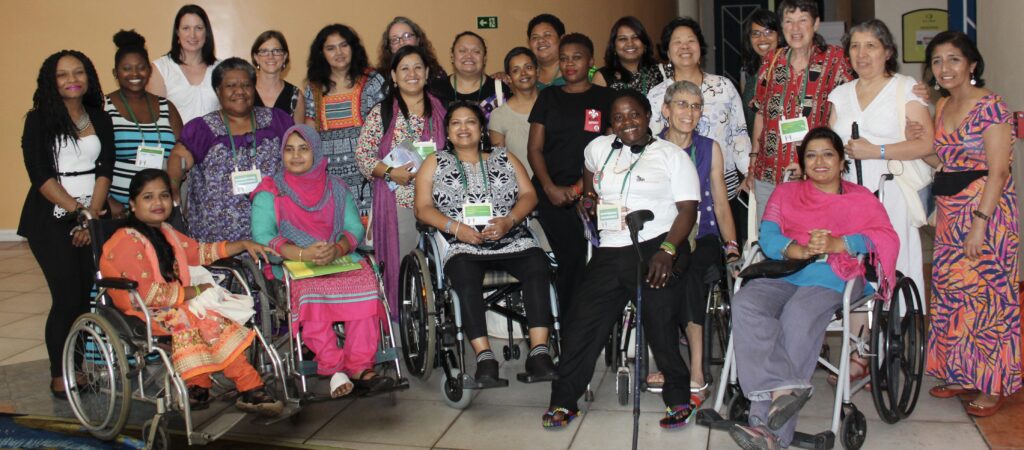Blog
Collective Power of Inclusion

Group of women from around the world gather for a photo at AWID
Despite this welcome moment, women with disabilities want more than visibility in global convenings. They want other advocates and donors to see their identities as women and support their activism. Not surprisingly, a recent survey by Women Enabled International found that women with disabilities prioritize the same urgent concerns as non-disabled women: gender-based violence, sexual and reproductive health, education and healthcare.
Women with disabilities all too often fall through the cracks: The mainstream disability rights field doesn’t place “gender” issues at the forefront of its priorities and women’s rights groups rarely know how to include women with disabilities.
Women with disabilities are calling for the programs, advocacy and funding that support women to include them, “lifting all boats.” For example, when donors and reproductive rights groups worked with women with disabilities on the Zika crisis, we saw stronger messaging and policy proposals that supported the rights of all women, including women with disabilities and mothers of children with disabilities. Including women with disabilities as equal partners in this effort is arguably what made it effective.
Three compelling arguments underlie the need for donors to strengthen their inclusion of women with disabilities:
- Understanding women with disabilities helps donors develop more accurate assessments, solutions, and informed advocacy strategies for all women’s issues
- Inviting women with disabilities to add their voices, power, and leadership strengthens coalitions of women
- Patriarchy cannot be addressed without addressing intersectional forms of discrimination
Extreme discrimination
The systems and norms that oppress women in general also oppress women with disabilities, but sometimes in different ways. Women with disabilities face discriminatory attitudes, beliefs and institutions that reflect both gender and disability stigma. The layering of minority identities, whether ethnic, religious or sexual orientation, exacerbates such discrimination.
Women with disabilities face extremely high levels of gender-based violence and sexual abuse, but have little access to protection systems due to the lack of accessibility and disability-related stigma. Many countries still allow forced sterilization and forced abortions, particularly of young women with intellectual disabilities. Including women with disabilities in sexual and productive health programs will strengthen all women’s right to make decisions about their own bodies, family structures and fertility.
Funding the Rights of Women with Disabilities
The funding community is just beginning to learn about the issues faced by women with disabilities. Disability donors (while few in number) must consider their work with a gender lens. Women’s rights donors must learn more about how their funding can include women with disabilities, or risk inadvertently marginalizing them.
To address this, several donors came together after AWID to increase the understanding of women with disabilities amongst colleague funders creating a brief entitled, Supporting Inclusive Movements: Funding the Rights of Women with Disabilities. The brief explores funding at the intersection of women’s rights and disability rights. While many donors acknowledge the importance of supporting women with disabilities, a funding gap remains.
The brief offers action steps for donors to include women with disabilities in their grantmaking and support this emerging community:
- Involve women with disabilities to develop grantmaking priorities and ask current grantees whether and how they work with women with disabilities
- Practice inclusion of women with disabilities in training, application examples and questions, outreach for calls for proposals and office accessibility
- Fund participation and inclusion of women with disabilities in grantmaking, capacity building, collaborations and convenings
- Learn and partner with peer donors to increase impact
Based on donor interviews and data from the International Human Rights Funders Group and Foundation Center, the brief documents the marginalization that organizations of women with disabilities face within the funding community. While women with disabilities comprise 2 of every 10 women around the world, only $1,500 of every $100,000 in funding includes women with disabilities (1).

As donors we are missing the untapped power of women with disabilities to change their own lives, strengthen opportunity and inclusion in their communities and advocate for the priorities that all women care about. As one donor noted, “We can’t say that we are supporting women’s rights unless every group is at the table.”
Women with disabilities and their organizations are passionate, energetic and committed to this urgent effort. Furthermore, these women want to work collaboratively and demand their rights unequivocally. With resources and partnerships in the women’s rights movement, donors have the opportunity to fuel this emerging movement. A recent report outlines some of this extraordinary work to advance equity for women and girls with disabilities.
 Catherine Hyde Townsend is the Senior Program Officer, Wellspring Advisors and the Board Co-Chair, Disability Rights Fund.
Catherine Hyde Townsend is the Senior Program Officer, Wellspring Advisors and the Board Co-Chair, Disability Rights Fund.
1. Figures based on a manual review of the Foundation Center/International Human Rights Funders Group data set of 729 foundations that made at least 1 human rights grant in 2014. Totals for human rights funding for women and girls with disabilities include grants coded with both “women and girls” and “persons with disabilities” as populations supported by that grant.↩
Resources
- Disability Rights Fund Donor’s Guides to Inclusion
- AWID’s Who can fund my women’s rights organizing? https://www.awid.org/fund-me